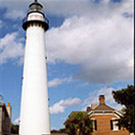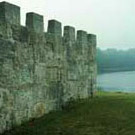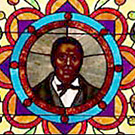


























|
| History will touch you. Discover what Georgia’s Historic Coastal Cities hold within their streets. There's so much is waiting for you to explore! |
| Brunswick Old Town – This deep water port town contains an outstanding collection of late 19th century residential and public buildings. Among the best examples are the Hazelhurst-Taylor House (Hanover Square), the Mahoney-McGarvey House (Reynolds Street) and the Old City Hall. The town also retains many of its original sidewalks paved with unusual hexagonal stone tiles. The heart of the downtown district is historic Newcastle Street lined with Victorian buildings, shops, art galleries and restaurants. |
| Cumberland Island - Sun, sand, beautiful vistas, wild horses, old historic ruins, and a relaxing atmosphere await you! Cumberland Island is GA's largest and southernmost barrier island. Pristine maritime forests, undeveloped beaches and wide marshes whisper the stories of both man and nature. Come walk in the footsteps of early natives, explorers, and wealthy industrialists. Cumberland Island is a unique 'must see' for all Georgia travelers. |
| First Bryan and First African Baptist Church - In 1793 Bryan obtained the lot where the First Bryan Baptist Church (constructed in 1873) now stands. It is the very first black Baptist church to be established in America. The church owes its formation to the work of three men -- David George, George Liele, and Andrew Bryan -- who were brought together by the American Revolution. The First African Baptist Church of Savannah, GA evolved from it in 1859. Check out the historical time-line of the Oldest Continuous Black Baptist Church in America and The First Baptist Church in Savannah with over 200 years of Christian Service. |
| Fort Frederica - In 1742, during the War of Jenkins' Ear, English and Spanish forces fought in an encounter later known as the "Battle of Bloody Marsh". The origin of the name came from the marsh supposedly "running red with the blood of Spaniards". However, official Spanish records indicate that only 7 grenadiers died during this battle. Due to the efforts of Lt. Patrick Sutherland of the 42nd Regiment of Foot and the Highlanders from Darien, the battle was a British victory, ending the Spanish claim to GA. Check out the beautiful ocean views, the grounds and see the first lighthouse built on St. Simons Island in 1810, which was constructed from material scavenged from Fort Frederica. |
|
| Fort King George - From 1721-1736, Fort King George was the southern outpost of the British Empire in N America. Scout men led by Colonel John “Tuscarora Jack” Barnwell constructed the cypress blockhouse, barracks and the palisade earthen fort in 1721. The fort was destroyed by fire in 1726 and rebuilt the following year. The surviving portions of the first sawmill are significant and rare examples of early colonial industry in Georgia. A museum interprets the history of the area, including the early occupation of the site by the Guale Indians. It also includes a reconstructed blockhouse. |
| Fort Morris - First fortified in the 1750s, the fort was manned to protect the once prosperous seaport town of Sunbury. When the Continental Congress convened in 1776, the delegates recognized the importance of a fort to protect their growing seaport from the British. Fort Morris was surrendered to the British on January 9, 1779, the last patriot post to fall in the American Revolution. Today, visitors can stand within the earthwork remains and view scenic Saint Catherines Sound. A museum and film describe the colonial port of Sunbury and the site's history. |
| Fort Pulaski - This National Monument offers visitors the chance to experience many interesting and exciting activities year-round. Fort Pulaski itself is a large-scale outdoor exhibit. The main structure, together with outlying works including demilune, drawbridges, ditches, and dikes, is a fine example of historic military architecture. Indoor exhibits highlight the history of Fort Pulaski from the fort's construction, to its eventual fall due to advancing military technology. |
| Hamilton Plantation - Located on St. Simons Island, the remains of this antebellum plantation contain two surviving slave cabins, originally a set of four built before 1833. Utilizing a duplex plan to house more than one family, the cabins were originally part of a planned community of slave dwellings. |
Hofwyl-Broadfield Plantation - This beautiful plantation represents the history and culture of Georgia’s rice coast. In the early 1800s, William Brailsford of Charleston carved a rice plantation from marshes along the Altamaha River. The plantation house, "Hofwyl House," was probably constructed by slave labor in the 1850s. Modeled after a large farmhouse with the original kitchen and a cabin connected to the house by long passages.
One of the more notable features in the house is the ornate marble fireplace in the dining room. The furniture in the house spans several centuries and includes many rare pieces. The plantation grounds are landscaped with large oak trees, most of which are very old. Tabby ruins, likely the foundation of the rice mill, and several surviving outbuildings, including a barn and an ice house, are located on the property. Museum interprets a working a rice plantation, and the life of slaves and planters. |
|
| Isle of Hope Historic District - Established as a retreat in the 19th century for the elite of Savannah, Isle of Hope provided a refuge from the intense heat and outbreaks of malaria prevalent throughout the summer months. Landscaped with old oak trees covered in Spanish moss, the houses range in style from Greek Revival, Victorian, and Neoclassical to Craftsman Bungalows. Many of the residences also have both formal and informal gardens. |
| Jekyll Island Historic District - Occupied by the Guale Indians who called the area Ospo, the island was a popular hunting and fishing site. General James Edward Oglethorpe, founder of Georgia, maintained an outpost on the island, and a plantation was established by one of his officers, Maj. William Horton. In 1794 a French family, the du Bignons, bought the island. They retained possession until 1886 when it was sold to the newly formed "Jekyll Island Club." Considered to be the most exclusive social club in the United States, the Jekyll Island Club had a limit of 100 members, among them the Astors, Vanderbilts, Pulitzers, Morgans and McCormicks and was laid out by prominent landscape architect H.W.S. Cleveland. |
| Laurel Grove Cemetary - This Cemetery is significant as a visual record of African American history in Savannah. The cemetery was separated from the white Laurel Grove-North Cemetery by what is now Hwy 204. Tombstones range from small markers with little or no ornamentation, to monumental markers with elaborately carved figures. Inscriptions on many of the tombstones record African American history not included in written histories of the region. The cemetery is a public park-like open space with massive cypress trees towering from its wetlands. |
| The Midway Historic District - The colonial town of Midway, founded in 1752 by the New England Puritans, was once an influential center for political, economic and religious life. These colonists were strongly in favor of independence from Great Britain, and during the Revolution the British burned the church and most of the buildings in the town. |
| Savannah Historic District - This National Historic Landmark is significant for its distinctive grid plan as well as its 18th and 19th century architecture. Most of the original squares are surrounded by fine examples of buildings in the Georgian, Greek Revival, and Gothic styles. The extension of street railways in the late 19th century spurred the development of Savannah's Victorian District. The wood frame houses dating from the 1870s and 1880s are a mixture of several Victorian styles of architecture. Some of the best examples of these are the Carpenter Box style houses on West Gwinnett Street embellished with ornate brackets and cornices, the Queen Anne style mansion at the corner of Whitaker and Gwinnett, and the imposing Victorian Telfair Hospital on Park Avenue. |
| St. Marys Historic District - Saint Mary's City, founded in 1634 and serving as the provincial capital of Maryland until 1695, is probably the only remaining major 17th century town site in the United States that has never been overbuilt. St. John's House, a significant contributing element within the District, is one of the best preserved 17th century archaeological sites in the country. During the late 18th century, St. Marys was a bustling seaport. Historic sites in the district include the "Washington Oak," the only remaining tree of four oaks planted in 1799 on the day George Washington was buried and the 1808 Presbyterian Church, famous for its historic bell, which was cast by Paul and Joseph Warren Revere. |
| Wormsloe Plantation - Wormsloe was Noble Jones' country estate where he experimented with his grand passion — horticulture. He protected the cypress and oak forests of his property and never cultivated the land. The surviving ruins of the original house are one of the only remaining examples of fortified houses once common throughout coastal Georgia. The site includes a plantation house built by Jones' grandson in 1828, a detached library, the ruins of a fortified house, a mile-long drive bordered by large oaks, and Confederate earthworks. |
|
|
|
|






|













